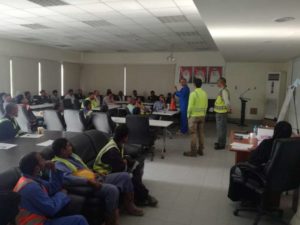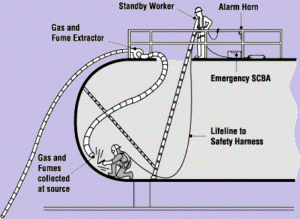what is confined space safety and measures

what is confined space safety and measures? Confined spaces may be present at the workplace that must be entered to perform any work. Just entering a confined space already entails risks. In addition, there is a risk associated with the work in that confined space. Prior to entering such an area, the risks must be assessed through risk assessment and appropriate measures must be taken. This article discusses the common risks of confined spaces and the safety measures to be taken.
What is a confined space?
- A confined space is a term used for spaces with one or more of the following characteristics:
- Closed or partly open;
- Limited access and egress options,
- Not designed for the stay of people or human occupancy;
- Possible residues of toxic or flammable substances and/or too little or excessive percentage of oxygen.
Examples of confined spaces
Some examples of confined spaces are
- Manholes
- Catch pits
- Silos
- Trenches and excavations deeper than 1.2 meters
- Closed containers
- Cellars;
- Installation rooms;
- Crawl spaces under floors;
- Boilers and storage tanks (tanks);
- Sewer systems;
- Pits and slots.
Risks in confined spaces
The most important risks when working in a confined space are:
- suffocation or intoxication;
- Fire and explosion;
- Poisoning;
- Falling and slipping;
- Electrocution;
- Contact with moving parts.
Safe entry into a confined space
The necessary safety measures are described below before and during work in a confined space.
PREPARATION PHASE:
- Planning of the work.
- Performing Task Risk Analysis (TRA) and determining necessary safety measures;
- Make arrangements about alarming and rescuing people from the confined space. The first-aiders must be trained in rescuing people from the confined space;
- Securing the confined space: physically separating the confined space from the operational pipework, emptying and cleaning the space, ventilating the space and locking moving parts.
- Additional measures: any risk-increasing processes and / or work in the vicinity of the confined space. What is confined space definition and dangers
IMPLEMENTATION PHASE:
- Prior to entering the confined space, all parties involved must check whether the safety measures listed on the safe work permit and TRA or risk assessment have been taken:
- Is the confined space safe and secure enough?
- Is correct working ventilation has been installed prior to entry?
- Do all entrants have the right personal protective equipment that is suitable for the task?
- Is a competent and certified confined space attendant appointed?
- Is the right measuring equipment present e.g. multi and personal gas monitors? what is confined space safety and measures
- Is the right communication and rescue equipment available e.g. wireless or bravo etc?
- An authorized person must perform the gas testing measurement and document it in a gas monitoring log sheet with suitable and 3rd party certified gas measuring equipment. It must be checked whether there is a safe atmosphere or not if not work cannot proceed until the atmosphere is not suitable for the work:
- Oxygen concentration must be from 19.5 to 23.5 by %;
- The concentration of CO carbon monoxide must be less than 35 PPM;
- The concentration of flammable gases or vapors: <10% LEL (10% of the lower explosion limit) LEL must not exceed 10%.
- Hydrogen sulfide must be less than 10 PPM
- If the above conditions cannot be met, the confined space may not be entered! Then additional measures are necessary to make the atmosphere safe for entering and working inside.
Other important points of attention
During the work, it is advisable to repeat gas monitoring measurements periodically. Due to circumstances and activities, the atmosphere in the confined space can change e.g. if the oxygen level was within the limits while the work was started and the welding work has been started it is 100% surety that the oxygen level will decrease and toxic fumes generated through welding will make the confined space highly toxic for the entrants. In addition, it is advised to equip entrances with an alarming personal gas monitor. See also What is confined space and its characteristics
The duration of the stay of the entrants in the confined space is to be limited as much as possible, whereby they are constantly monitored by a confined space standby person.
The confined space attendant must never enter the confined space! Even in the event of an emergency. He has the task to record the measurement results in writing on the entry-exit log sheet and gas testing records on gas monitoring log sheets or checklist, to keep records of the person and if necessary, to initiate the emergency procedure. See also How to rescue in confined space
The escape route must remain free of all obstruction and obstacles and the route to the confined space must be accessible to emergency rescue teams and services.
Confined space must not be left unattended even for a minute the situations can be changed in seconds. The area must be provided with hazard warning signs and must be properly barricaded to avoid unauthorized access. Unauthorized entry is not allowed signages must be provided along with confined space entry by permit only signs must be provided.
Tool Box talk must be conducted before entry into confined space and must sure that the message in the toolbox talk is properly delivered in the native language of the entrant and they have understood all the message and the requirements of the working. Always remember when in doubt stop the work ask and learn. See also How to make confined space entry procedure







